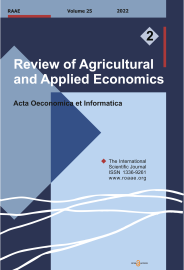KEYWORDS:
Camel, Determinants, Livestock, Pastoralists, Production, Ethiopia
DOI NUMBER:
10.15414/raae.2020.23.02.12-20
ABSTRACT:
This study aspires to identify determinants of pastoralists’ choice of camel production and production systems in Korahay zone of Somali regional state, eastern Ethiopia. A cross sectional survey methods were applied to collect data from 158 sampled households in which 84 households were camel owners obtained through snowball sampling approach and remaining 74 households were non-camel owners obtained by using random sampling technique from three districts of Korahay zone in Somali regional state namely Kebridahar, Shelabo and Shekosh. The results of binary probit regression model revealed that socio-economic determinants including total livestock unit, farm income, non-farm income; herd size and distance from the nearest market were found to positively influence the likelihood of owning camels. Where, other determinants like age of the household head, household size and education level, dependent ratio, and distance from extension service were found to negatively influence the likelihood of owning camels. The overall regression model used indicated significant at 1% significance level (p=0.0013) which imply that all the supposed determinants jointly influenced the decision of pastoralists choice of camel production. In the study areas, majority of camel producer (77.8%) rear camels for income generation, milking production, social and cultural functions. The three main production systems in the study areas were transhumant (71.5%), sedentary system (19.6%), and pastoral nomadic (8.9%), which seems nomadism disappearing in the study areas. Feed shortage (30.4%), drought and water shortage (41.8%), disease prevalence (18.3%), and market problems (9.5%) are the major constraints of camel production in the study area. Majority of pastoralists in Korahay zone of Somali region (77.2%) use extensive camel management system, and they cover long distance of around 12 to 18 km every day for grazing and browsing activities. In general, policy makers and government bodies should take in to consideration these variables determining the choice of camel production, and the current more pressing problems for pastoral communities such as drought and water shortage, lack of veterinary services, market problems, lack of enough capital for investment, and low access to credit services. It is strongly believed that consideration of these problems can enhance the life and livelihood of pastoral communities.
Please Cite this Article as:
Abduselam ABDULAHI, Kibebew BABEGE, Abreham ZUMA (2020) Determinants Of Pastoralists Choice Of Camel Production And Production Systems In Eastern Ethiopia. Review of Agricultural and Applied Economics. XXIII (Number 2, 2020): 12-20. doi: 10.15414/raae.2020.23.02.12-20
URL for sharing:
https://roaae.org/1336-9261/doi/abs/10.15414/raae.2020.23.02.12-20
FULL TEXT PDF:
▼ direct download link| view online in fullscreen ▲
References:
▼ direct download link

